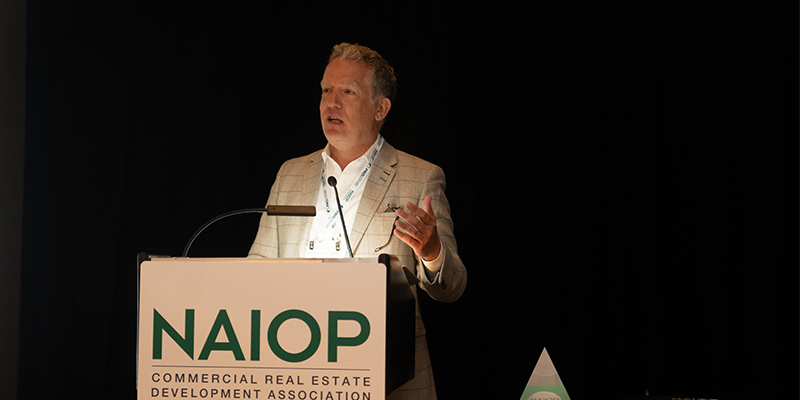Understanding the ever-evolving regulations and reporting requirements around ESG can be challenging. A panel of industry experts spoke to I.CON West attendees on why these regulations are about more than compliance. They can lead to market differentiation, improved communication with tenants, and interest from global investors.
Moderator Megan Krest, associate director of ESG at Cushman & Wakefield, asked the panelists about their work in California involving reporting and compliance. Ethan Gilbert, director of global ESG at Prologis, discussed AB 802, a California law requiring buildings over 50,000 square feet to submit annual energy consumption data to the state.
“It’s a challenge because most industrial owners are operating under a triple net lease model, so utilities are under the direct control of our tenants,” he said. “The usage is not something the landlords have insight into, yet the state holds us accountable.”
Prologis has been modifying its lease language to make sure that they have data-sharing agreements in place to ensure the company has access to the information needed to meet compliance obligations. It’s taken some work to help tenants understand why Prologis needs this data and what they intend to do with it. “We don’t want to share this publicly. We don’t want to give away your secret sauce, but we want to make sure that we can work together on improving the performance of the asset,” Gilbert said. He’d like utilities to share their data more easily, too.
The panelists agreed that benchmarking required by AB 802 is just the first step. Landlords will soon go from measuring energy consumption to adhering to energy consumption limits outlined during the benchmarking phase.
The panel then discussed the implications of: (1) California’s SB 253, which requires U.S. companies with annual revenues exceeding $1 billion doing business in California to disclose their Scope 1 (energy a company burns) and 2 (energy a company buys) greenhouse gas (GHG) emissions data starting in 2026 and their Scope 3 (everything beyond burning and buying) GHG emissions data by 2027; and (2) The Securities and Exchange Commission’s rules to enhance and standardize climate-related disclosures by public companies and in public offerings.
Gilbert said most of the energy consumption from Prologis’ property is considered Scope 3 but property owners “need to continue to evaluate portfolio’s performance, the performance of your operations and how your corporate operations fit into Scope 1 and 2 reporting requirements. We must raise the bar of environmental reporting to meet financial disclosure quality.”
Gilbert works closely with his companies’ financial reporting and accounting departments as he must ensure that the ESG information he provides is of the same rigor and quality as the financial disclosures that they’re putting in. “I need to have it auditable and traceable, and confirmed that this is actual information and I’m clear about whatever information I’ve provided,” he explained.
Breana Wheeler, director of operations at US BREEAM USA, said energy compliance may seem onerous but it can create opportunities. Reporting requirements can be used as a new way of working with tenants, for example. “Addressing energy consumption can show them how they can get a little bit better at controlling their costs,” she said. “They can better understand how they can improve their operations.” Obtaining and maintaining certifications can be an effective way to explain to your current and prospective tenants the value-add features of the building. These interactions are also ways of building trust among tenants so that they feel more comfortable sharing their energy data.
Andrew Morrow, executive managing director, Cushman & Wakefield, commented that mostly Fortune 500 companies or large-cap industrial tenants are interested in ESG, and he wasn’t seeing a lot of smaller tenants proactively try to get in front of the issue. However, if developers are seeking European investors, they will have to meet certain environmental expectations. Going through ESG reporting requirements helps an owner communicate with outside investors, particularly ones who require high levels of environmental awareness and risk management. The panelists agreed that the financial markets are leading the charge on ESG more so than the regulators.
Krest asked the panel how ESG requirements would shape the physical assets and their marketability. Adding these features not only improves resiliency but may lead to less tenant disruption, better employee retention rates and an increase in rents. Gilbert added, “Companies may come to look at it as ‘I want to be in the best quality asset because it helps my employees. It helps me retain labor. It provides the power needs that I have. It gives me resiliency to avoid a brownout so I can maintain operations and I can continue to operate effectively, and it’s well positioned for the future by having electric vehicle charging.’”
Gilbert quoted a colleague from Boston Properties who summed up the ideal approach: “Build tight, ventilate right, and energize with sunlight.”

This post is brought to you by JLL, the social media and conference blog sponsor of NAIOP’s I.CON West 2024. Learn more about JLL at www.us.jll.com or www.jll.ca.








